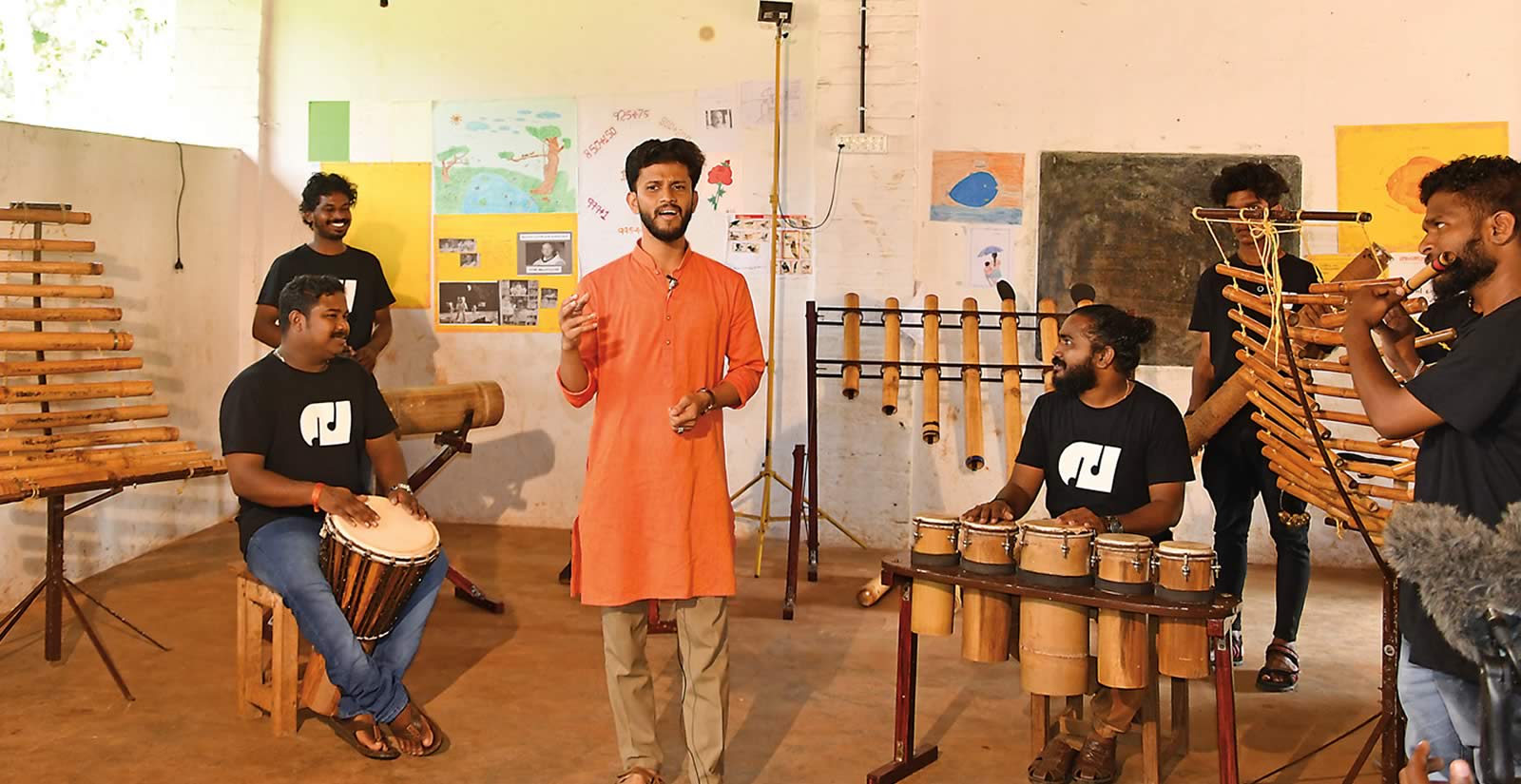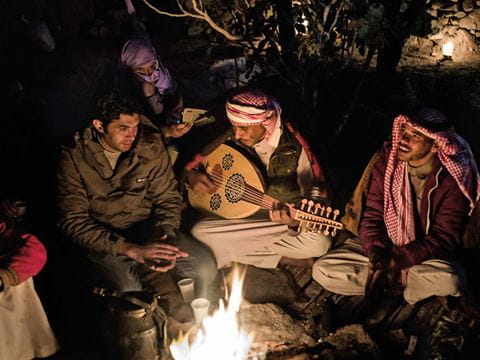
Mappila Rhythms, Monsoon Connections
It was mainly the pepper in Kerala, at the southwest tip of India, that lured early traders to ride seasonal monsoon winds across the Arabian Sea. With the mariners came music that mixed with Keralan sounds to become the complex, percussion-driven traditions of today’s Mappila culture.
Down a muddy road shimmering with puddles, voices chanting in a temple mix with a nearby drummer’s pulsing thakita thakita beats, all while rain patters on the bamboo roofs in Arangottukara, a village in the southwestern Indian state of Kerala. As if in randomly playful accompaniment, children run by lilting, “Rain, rain, go away, come again another day!”
Such mixtures of musical sounds can at times seem to infuse the very landscape in this village and throughout Kerala, reaching 600 kilometers up India’s west coast nearly from the subcontinent’s southern tip. Renowned for its coastal, beach atmosphere, plush greenery and abundant rivers, it is also one of India’s most culturally and religiously diverse regions, resulting in communities where mosques, temples and churches can often appear on the same street. For anyone interested in vernacular musical traditions throughout the world, Kerala is sublime.


It was to this part of Kerala that Islam came in the seventh century, and the music of the region has since been one of traditional chants, both secular and sacred, reminiscent of the Arabian Peninsula, together with the hallmark percussion of classical Keralan music. The results are exciting even to the most novice of ears, an amalgamation of tones and improvised rhythms developed over centuries.
This musical tradition was made possible by the spice trade that serviced ports in what is now Oman, the uae, Saudi Arabia and more. Mariners largely followed coastal routes to traverse some 3,000 kilometers of the Arabian Sea, and some stayed on in the fertile deltas of Kerala, much of which was then known as Malabar. With them they brought music, religion, cuisine and other aspects of culture. Today Kerala is comprised of around 25 percent Muslims, 20 percent Christians and 55 percent Hindus. It’s a diversity not seen in other states of India, where Hinduism remains dominant by larger margins.


Mappila villages are mainly settled in the northern part of Kerala, many along the coast, where occupations in trade, farming and fishing endure. Because Kerala’s landscape is so lush, it can feel a world apart from other faster-moving, more crowded parts of India. Here the land is forest green, dominated by coconut and areca nut palms, banana bushes and nut plants, especially the famed Kerala cashews. The “black gold” of the Piper nigrum vines—black pepper—did more than anything else growing here to inform the region’s history, ever since Alexander the Great is said to have carried some back from India. In the 14th century, the Moroccan traveler Ibn Battuta described Kerala’s coast as the “pepper country.”

“With tiny wooden ships called dhows, the traders arrived in June and July and returned to their own places in December and January using the changed wind direction caused by the monsoons.”
—T. V. Abdurahimankutty, historian
Vayali, a Kerala-based music and cultural preservation group, is now working to map distinct cultural expressions along Kerala’s rivers, from their sources in the state’s Western Ghats (hills) to the coast. Vayali’s online resource shows cultural connections among communities, regions and even nations, with a particularly musical focus on the towns of Arangottukara, Ponnani, Tirurangadi and Kondotty—the latter three Mappila cultural centers.
Where the estuary of the river Bharatappuzha meets the Arabian Sea, Ponnani’s dilapidated waterfront warehouses, well-worn fishing boats, and simple houses and sheds characterize one of Kerala’s oldest ports. Town historian T. V. Abdurahimankutty says the importance of Ponnani grew with the rise of trade in local spices, most significantly pepper.
“With tiny wooden ships called dhows, the traders arrived in June and July and returned to their own places in December and January using the changed wind direction caused by the monsoons,” he says. “Many Arabs or Persians created families with local people, and some stayed on permanently.”
Abdurahimankutty says it was during the traders’ long stays on the coast that they developed music “combining the laments of the Arabs with the percussive elements prevalent in Kerala.”
In addition to the music, the 600-year-old grand mosque in Ponnani shows how Arab sailors and residents merged their culture with a new environment and local architecture. The mosque is made of natural stone and intricately carved wood, and it resembles one of the early royal palaces of the region.
Mohamed Haseeb of Ponnani is a master singer of the three main Mappila musical genres: Mappila pattu, kolkali and duff muttu, which all combine storytelling lyrics, hymns and poetry with intricate percussive patterns—but each for distinct purposes and each using distinct musical forms.



“I have played this exciting music from childhood onwards,” Haseeb says.
Mappila pattu (song) is the most important genre performed in Tirurangadi, a town just north of Ponnani. Ethnomusicologist Amy Catlin-Jairazbhoy, adjunct professor at the University of California, Los Angeles, has described Mappila pattu’s characteristically responsorial songs supported by handclapping as “reminiscent of their ancestors from the Arab world.”
Haseeb says the genre may be more diverse.
“In this genre the topics vary from an invocation to God to one that marvels at the beauty of women,” he says. “The song lyrics also deal with Mappila food, the anticolonial struggle and wedding celebrations. Each performance has its specific time and space.”
As is common nowadays, the singers in Tirurangadi accompany themselves on instruments of the north, mostly tabla and the pumped-reed harmonium. Haseeb says these were introduced through the film industry of Mumbai, where together with western instruments, they support many of the singers in the Bollywood film scene.
At Pocker Sahib Memorial Orphanage College in Tirurangadi, students also learn the music and moves of the intricate kolkali (stick dance). It is performed by young men wearing traditional loincloths, white T-shirts, broad green belts and white knotted handkerchiefs on their heads; in their hands they hold stout wooden sticks.
The songs start with an invocation, after which performers whirl around, stamp their feet and bang sticks toward each other. The rhythm gets faster and faster, the steps more and more complex, and it ends in a crescendo. If in Mappila pattu the tabla is merely an accompanying instrument, the sticks in kolkali dominate the fast-changing rhythms. The intensity and seemingly wild patterns, and the ever-increasing speed, are typical for Kerala’s drum orchestras too. If Mappila pattu is closer to Arab culture, kolkali belongs more to the Dravidian south Indian musical realm. Stick dances are performed in many villages along the coast of the Arabian Sea from Kerala to the north Indian state of Gujarat.

“This musical genre is truly devotional,” says Haseeb. “It nearly always celebrates the life of the Prophet Muhammad and praises the almighty God.”
The performers kneel, and they begin with an invocation. Then they beat their small, round frame drums, held in the left hand, and slowly sway as the rhythm accelerates.
“The lyrics of this genre are only in Arabic, and no other language is used,” he says. “It is entirely religious.”
A clear dichotomy of cultural influences exists in Mappila music: The Arabic language, the duff (frame drum) of Arab origin and the lyrics expressing Islam all point directly to the relationship and influence of immigrants from the Arabian Peninsula. The duff, with its rather broad wooden rim, is similar to the frame drum mirwas played in many Arab countries.

On this day of performances, each corner of the school building reverberates with Mappila songs, and students practice dance in several audience halls and classrooms. Dozens of girls and boys 7 to 18 years old arrive, then disappear, chatting in one of the nearby classrooms as they prepare for their performance. They emerge, and soon there are songs, clapping, drumbeats and roaring harmoniums.
In yet another town, Kondotty, north of Tirurangadi, the Mappila Academy is one of Kerala’s leading cultural centers, and it emphasizes music and dance education. Here, seven teenage girls rehearse a fourth, more specific tradition: the oppana, a wedding dance whose name means “clapping together.” The girls’ teacher is Master Ahmet, who explains that when oppana is performed at a wedding, a girl is bedecked with gold and remains in the center of the dance, symbolizing the bride before marriage. She is lavished with all the attention. The other girls, each wearing a long, plain white sari and headdress, spin and dance around her as three vocalists position themselves to the left of the women, singing of the love and joy between husband and wife. Today, Ahmet’s dancers are dressed in everyday clothes: jeans, long skirts and loosely knotted headscarves. Apologizing, he explains this is a dress rehearsal. In the past, he adds, all Mappila villages had oppana groups, but they are on the decline.
“To my experience the Mappila have astoundingly well-maintained their specific Indo-Arabic traditions and belief system. This is mainly due to our strong fondness for music and dance.”
—Master Ahmet
Ahmet, who is also the school’s teacher for Mappila Pattu and a player of the harmonium, says the arts remain central to Mappila identity.
“To my experience, the Mappila have astoundingly well-maintained their specific Indo-Arabic traditions and belief system. This is mainly due to our strong fondness for music and dance,” he says, noting it’s important to carry on traditional music in Mappila schools, especially, he emphasizes, since much is now mixed with, or entirely replaced by, the popular sounds of Bollywood.

In Arangottukara, the rain continues its soft background rhythm as the members of Vayali, who participated in the exploration of music in Mappila villages, decide to include this village’s songs and rhythms into their own group’s repertoire. Without hesitation, Haseeb and his friends join the effort.
“We are excited to work with the bamboo band,” he says.
On its own, Vayali’s percussion group sounds like the rain becoming a thunderstorm, interrupted only by long lyrical sequences foreboding the next downburst. The bamboo xylophone and flute provide the melodies, while a huge wooden drum and tuned bamboo tubes provide bass and rhythm. The beats and sounds are so dense one can no longer distinguish individual instruments: Sound collages are their specialty. Although the instruments are new inventions made of bamboo, the music is entirely Keralan—just the latest fusion among traditions that continue to connect cultures and continents.
“I knew it would work,” Haseeb says.
You may also be interested in...

Rajasthani Folk Musicians Are Curators of Culture
Arts
Reaching out to new generations and global audiences, musicians in India's northwest state of Rajasthan draw on centuries of traditions that, to an untrained ear, may sound like Indian classical music. But what sets them apart are the regional stories they tell and the tone and power of the singers.
Prince of Enchantment: The Oud
Arts
Often regarded as the forerunner and name- sake of the European lute, the ‘ud (oud), is among the world’s oldest continuously played string instruments. In Arab and other musical traditions, its deeply resonant, emotionally evocative tones earned it, over the centuries, the sobriquet amir al-tararb.
Tinariwen's Sahara Blues
Arts
Coming out of the struggles of post colonial desert Africa, Tuareg band Tinariwen adapted blues rock ‘n‘ roll guitars to North African traditions. The result has been nearly four decades of a sound that has inspired an entire genre of “desert blues,” in which themes of loss, home, hope and unity transcend language for audiences around the world.